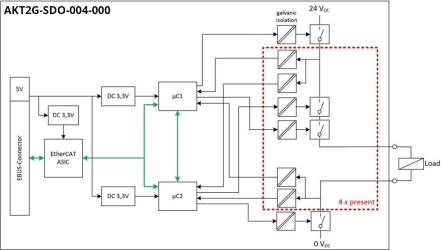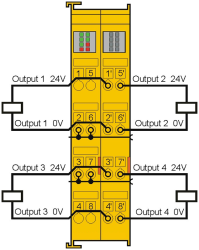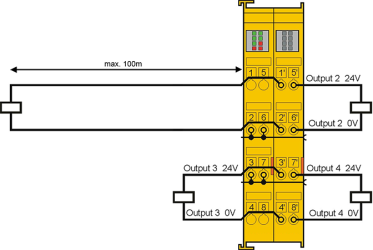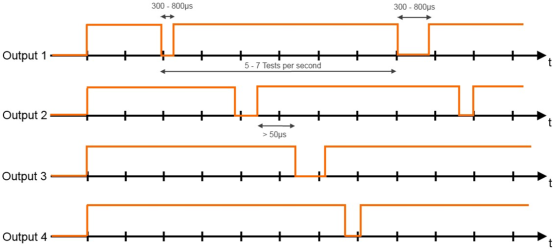AKT2G-SDO-004-000
Jump to a section on this page:
Safety terminal with 4 digital fail-safe outputs
The AKT2G-SDO-004 is a safe output terminal with digital outputs for connecting actuators![]() A mechanical device for moving or controlling a mechanism or system. An actuator typically is a mechanical device which transforms an input signal (usually an electrical signal) into motion (contactors, relays, etc.) with a maximum current 0.5 A (24 VDC). The Bus Terminal has 4 fail-safe outputs.
A mechanical device for moving or controlling a mechanism or system. An actuator typically is a mechanical device which transforms an input signal (usually an electrical signal) into motion (contactors, relays, etc.) with a maximum current 0.5 A (24 VDC). The Bus Terminal has 4 fail-safe outputs.
The AKT2G-SDO-004 meets the requirements of IEC![]() "International Electrotechnical Commission"
IEC is a not-for-profit, non-governmental international standards organization that prepares and publishes International Standards for all electrical, electronic and related technologies 61508:2010 SIL 3, DIN EN ISO 13849-1:2015 (Cat 4, PL e), UL508, UL1998 and UL991.
"International Electrotechnical Commission"
IEC is a not-for-profit, non-governmental international standards organization that prepares and publishes International Standards for all electrical, electronic and related technologies 61508:2010 SIL 3, DIN EN ISO 13849-1:2015 (Cat 4, PL e), UL508, UL1998 and UL991.
The safety terminal has the typical design of an EtherCAT![]() EtherCAT is an open, high-performance Ethernet-based fieldbus system. The development goal of EtherCAT was to apply Ethernet to automation applications which require short data update times (also called cycle times) with low communication jitter (for synchronization purposes) and low hardware costs terminal.
EtherCAT is an open, high-performance Ethernet-based fieldbus system. The development goal of EtherCAT was to apply Ethernet to automation applications which require short data update times (also called cycle times) with low communication jitter (for synchronization purposes) and low hardware costs terminal.
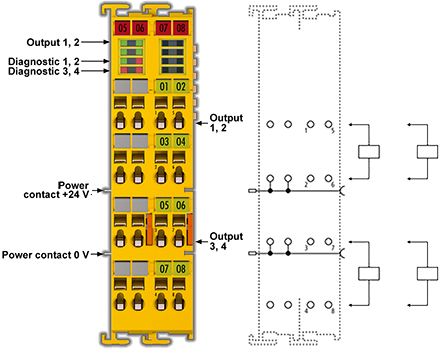
Figure 9-47: AKT2G-SDO-004-000 safety terminal with 4 digital fail-safe outputs
-
-
Be sure to review
Related Topics: Map Input and Output to Variables
| Parameter Name | Description | Values |
|---|---|---|
| Standard outputs | In addition the safe output can be switched off from the PLC |
True / False |
| Current measurement active | Current measurement for the outputs are activated | True / False |
| Testing of outputs active | Test pulses for the outputs are activated | True / False |
| Error acknowledge active | True:
Terminal errors lead to a reset of the FSoE connection (error code 14 (0x0E)). This error code is shown in the diagnostic data for the connection until it is acknowledged.
False (Default): Terminal errors can only be reset by switching the power supply off and back on again. |
True / False |
For example, using the BBH SafePLC2 software, the parameters can be configured from the AKT2G-SDO-004-000 Properties:
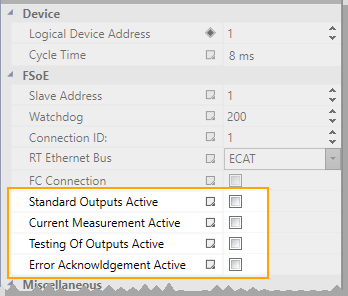
Intended use
-
-
Caution - Risk of injury!
Safety components may only be used for the purposes described below!
The safety terminals expand the application range of the E-Bus terminal system with functions that enable them to be used for machine safety applications. The safety terminals are designed for machine safety functions and directly associated industrial automation tasks. They are therefore only approved for applications with a defined fail-safe state. This safe state is the wattless state. Fail-safety according to the relevant standards is required.
The safety terminals enable connection of:
- 24 VDC sensors (AKT2G-SDI-004) such as emergency off pushbutton switches, pull cord switches, position switches, two-hand switches, safety mats, light curtains, light barriers, laser scanner, etc.
- 24 VDC actuators (AKT2G-SDO-004 such as contactors, protection door switches with tumbler, signal lamps, servo drives, etc.
-
-
Test pulses
When selecting actuators please ensure that the AKT2G-SDO-004 test pulses do not lead to actuator
 A mechanical device for moving or controlling a mechanism or system. An actuator typically is a mechanical device which transforms an input signal (usually an electrical signal) into motion switching or diagnostic message from the AKT2G-SDO-004.
A mechanical device for moving or controlling a mechanism or system. An actuator typically is a mechanical device which transforms an input signal (usually an electrical signal) into motion switching or diagnostic message from the AKT2G-SDO-004.
The following safety components have been developed for these tasks:
- The AKT2G-SDI-004 is an EtherCAT Terminal with 4 digital fail-safe inputs.
- The AKT2G-SDO-004 is an EtherCAT Terminal with 4 digital fail-safe outputs.
These safety components are suitable for operation on the
- Kollmorgen AKT2G-ECT-000-000 series Bus Couplers
-
-
Power supply from SELV/PELV power supply unit!
The safety components must be supplied with 24 VDC by an SELV/PELV power supply unit with an output voltage limit Umax of 36 VDC. Failure to observe this can result in a loss of safety.
-
-
Follow the machinery directive!
The safety components may only be used in machines as defined in the machinery directive.
-
-
Ensure traceability!
The buyer has to ensure the traceability of the device via the serial number.
Technical Data
|
Product designation |
AKT2G-SDO-004-000 |
|---|---|
|
Number of outputs |
4 |
|
Status display |
4 (one green LED per output) |
|
Error reaction time |
≤ watchdog times |
|
Output current per channel |
max. 500 mA, min. 20 mA with parameter current measurement active set |
|
Actuators |
When selecting actuators please ensure that the AKT2G-SDO-004-000 test pulses do not lead to actuator switching. |
|
Cable length between actuator and terminal |
unshielded max. 100 m shielded max. 100 m |
|
Wire cross section |
min. 0.75 mm2 |
|
Input process image |
6 bytes |
|
Output process image |
6 bytes |
|
AKT2G-SDO-004-000 supply voltage (PELV) |
24 VDC (–15%/+20%) |
|
Current consumption via E-bus |
approx. 221 mA |
|
Power dissipation of the terminal |
typically 2 W |
|
Electrical isolation (between the channels) |
no |
|
Electrical isolation (between the channels and the E-bus) |
yes |
|
Insulation voltage (between the channels and the E-bus, under common operating conditions) |
insulation tested with 500 VDC |
|
Dimensions (W x H x D) |
24mm x 100mm x 68mm |
|
Weight |
approx. 100 g |
|
Permissible ambient temperature (operation) up to SW 03 |
0°C to +55°C (see note in Installation position and minimum distances) |
|
Permissible ambient temperature (operation) from SW 04 (week 02/2014) |
-25°C to +55 °C (see note in Installation position and minimum distances) |
|
Permissible ambient temperature (transport/storage) |
-40°C to +70°C |
|
Permissible air humidity |
5% to 95%, non-condensing |
|
Permissible air pressure (operation/storage/transport) |
750 hPa to 1100 hPa (this corresponds to a height of approx. -690 m to 2450 m over sea level assuming an international standard atmosphere) |
|
Climate category according to EN 60721-3-3 |
3K3 (the deviation from 3K3 is possible only with optimal environmental conditions and also applies only to the technical data which are specified differently in this documentation) |
|
Permissible level of contamination according to EN 60664-1 |
level of contamination 2 (comply with the section Safety I/O Maintenance |
|
Impermissible operating conditions |
safety terminals must not be used under the following operating conditions:
|
|
EMC immunity/emission |
conforms to EN 61000-6-2 / EN 61000-6-4 |
|
Vibration/shock resistance |
conforms to EN 60068-2-6 / EN 60068-2-27 |
|
Shocks |
15 g with pulse duration 11 ms in all three axes |
|
Protection class |
IP20 |
|
Permitted operating environment |
In the control cabinet or terminal box, with minimum protection class IP54 according to IEC 60529 |
|
Permissible installation position |
see section Installation position and minimum distances |
|
Approvals |
CE, cULus |
Safety Parameters
|
Key Figures |
AKT2G-SDO-004-000 |
|---|---|
|
Lifetime [a] |
20 |
|
Prooftest Interval [a] |
not required 1 |
|
PFHD |
1.25E-09 |
|
%SIL3 |
1,25 % |
|
PFD |
8.45E-05 |
|
%SIL3 |
8,45 % |
|
MTTFd |
high |
|
DC |
high |
|
Performance level |
PL e |
|
Category |
4 |
|
HFT |
1 |
|
Element classification 2 |
Type B |
- Special proof tests are not required during the entire service life of the AKT2G-SDO-004 EtherCAT terminal.
- Classification according to IEC 61508-2:2010 (chapter 7.4.4.1.2 and 7.4.4.1.3)
The AKT2G-SDO-004 EtherCAT Terminal can be used for safety-related applications within the meaning of IEC 61508:2010 up to SIL3 and EN ISO 13849-1 up to PL e (Cat4).
For the calculation or estimation of the MTTFd value from the PFHD value, further information can be found in ISO 13849-1:2015 Table K.1.
Dimensions
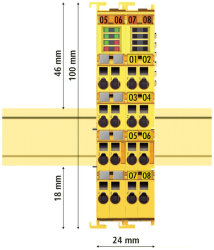
|
|
Figure 9-48: Dimensions of the AKT2G-SDO-004.
Block Diagram of the AKT2G-SDO-004
Figure 9-49: Block diagram of the AKT2G-SDO-004
The block diagram shows the basic configuration of a channel in the AKT2G-SDO-004. The part with a red border is present four times in the terminal. The high-side and low-side switches only exist once for all channels. This means that each channel has a total of four stop paths.
AKT2G-SDO-004 Pin Assignment
Figure 9-50: AKT2G-SDO-004 pin assignment
| Terminal point | Output | Signal |
|---|---|---|
|
1 |
- |
not used, no function |
|
2 |
positive power contact |
|
|
3 |
- |
negative power contact |
|
4 |
not used, no function |
|
|
5 |
- |
not used, no function |
|
6 |
positive power contact |
|
|
7 |
- |
negative power contact |
|
8 |
not used, no function |
|
|
1’ |
1 |
Output 1+ |
|
2’ |
Output 1- |
|
|
3’ |
3 |
Output 3+ |
|
4’ |
Output 3- |
|
|
5’ |
2 |
Output 2+ |
|
6’ |
Output 2- |
|
|
7’ |
4 |
Output 4+ |
|
8’ |
Output 4- |
-
-
Test Pulses
When selecting actuators please ensure that the AKT2G-SDO-004 test pulses do not lead to actuator switching or diagnostic message from the AKT2G-SDO-004.
Signal Cables
Permitted cable length
Figure 9-51: Permitted cable length
When connecting a single switching contact via its own continuous cabling (or via a non-metallic sheathed cable), the maximum permitted cable length is 100 m.
The use of contact points, connectors or additional switching contacts in the cabling reduces the maximum propagation.
Cable routing
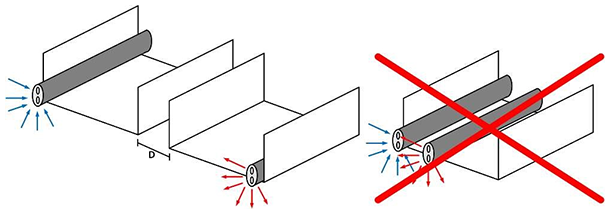
-
-
Route the signal cable separately
The signal cable must be routed separately from potential sources of interference, such as motor supply cables, 230 VAC power cables etc.!
Interference caused by cables routed in parallel can influence the signal form of the test pulses and thus cause diagnostic messages (e.g. sensor
 A sensor is a type of transducer that converts one type of energy into another for various purposes including measurement or information transfer errors or OpenLoad errors).
A sensor is a type of transducer that converts one type of energy into another for various purposes including measurement or information transfer errors or OpenLoad errors). - D: Distance between the cable ducts should be as large as possible
- blue arrows: signal line
- red arrows: potential source of interference
The common routing of signals together with other clocked signals in a common cable also reduces the maximum propagation, since crosstalk of the signals can occur over long cable lengths and cause diagnostic messages.
The test pulses can be switched off (sensor test parameter) if the connection of a common cable is unavoidable. However, this then leads to a reduction in the degree of diagnostic cover when calculating the performance level.
Test Pulses
The typical length of test pulse (switching from 24 V to 0 V and back to 24 V) is 300 µs to 800 µs. Testing usually takes place 5 to 7 times per second.
-
-
Test pulses for the outputs
The following diagram shows a typical test pulse curve for the four outputs of an AKT2G-SDO-004. The parameters Current measurement active and Testing of outputs active are enabled.
